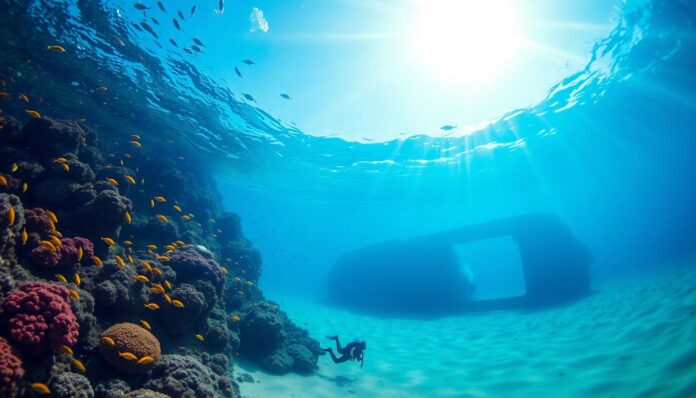| Best Time to Travel | October to April |
| What to Expect | Warm water, clear visibility, diverse marine life |
| Diving Conditions | Year-round, but best from October to April |
| Marine Life | Whale sharks, dolphins, turtles, sharks, moray eels, fish |
Ever dreamed of diving in an underwater paradise? Imagine crystal-clear waters and stunning marine life. Egypt’s Red Sea offers the most amazing scuba diving experience on Earth.
Scuba diving in Egypt is a top-notch adventure that draws divers from everywhere. The Red Sea is a top spot for diving, with 360 days of diving every year. With over 1,800 miles of coastline, Egypt has endless diving opportunities for all levels.
The Red Sea is special because of its clear waters and high salinity. These conditions make for an unforgettable dive. Divers can see colorful coral reefs, meet different sea creatures, and see some of the most beautiful underwater views.
Key Takeaways – Scuba Diving in Egypt
- Egypt offers year-round diving opportunities with 360 dive days annually
- The Red Sea features exceptional water clarity and unique marine ecosystems
- Divers can explore over 1,800 miles of diverse coastline
- Multiple world-class dive sites are available across different regions
- Red Sea diving provides opportunities for both beginners and advanced divers
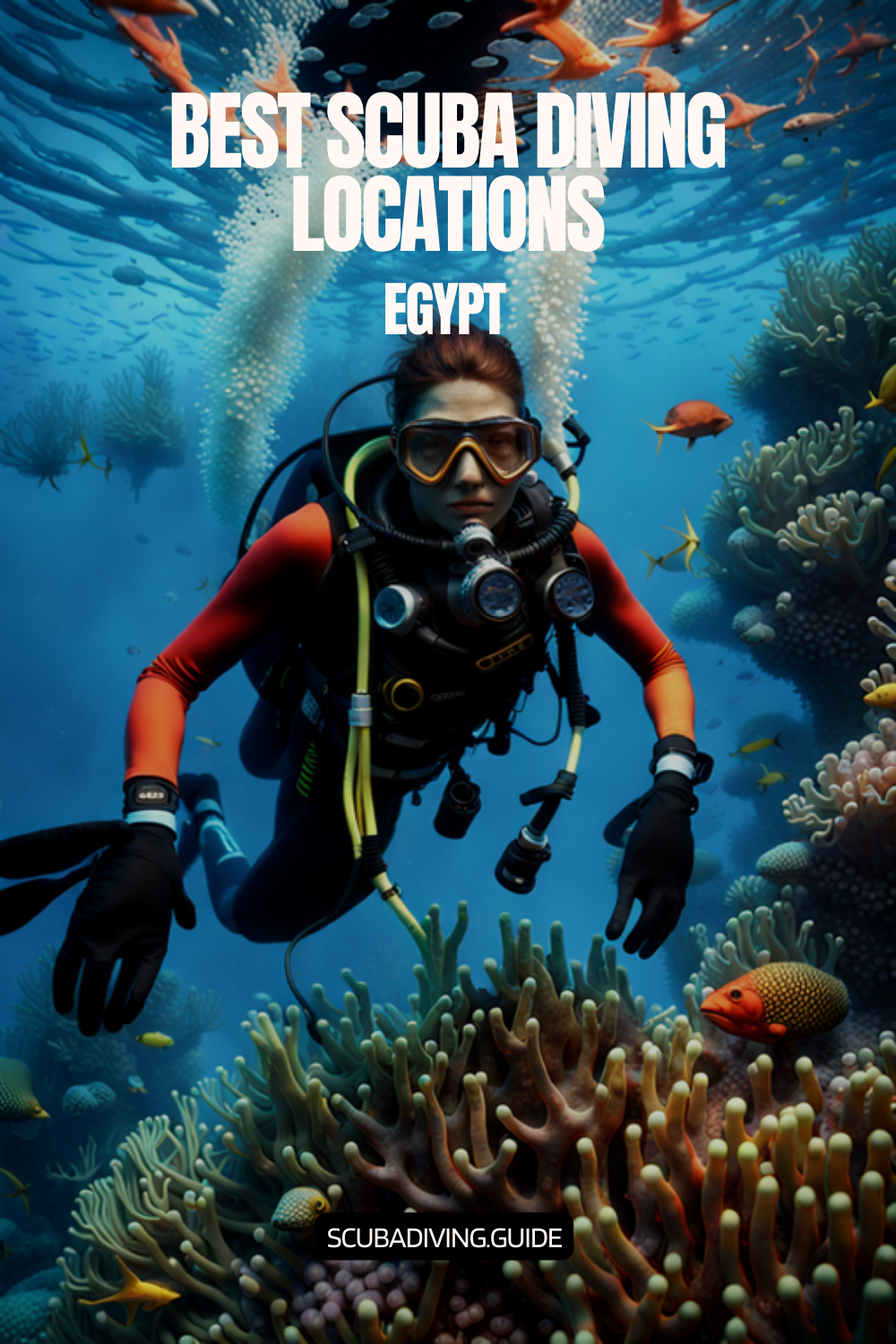
Overview of Scuba Diving in Egypt
Egypt’s Red Sea is a top spot for scuba diving. It has a unique marine ecosystem that’s unlike anywhere else. With over 1,800 miles of coastline, it offers an amazing diving experience for all levels.
The Red Sea is known for its incredible marine life. It’s a favorite among divers worldwide. Highlights include:
- Over 1,200 fish species
- More than 200 coral species
- Unique marine ecosystems
- Exceptional underwater visibility
Importance of the Red Sea for Divers
Diving in Egypt’s Red Sea is truly spectacular. The area’s geology creates amazing diving spots. Water temperatures range from 21°C to 28°C, and visibility can be over 40 meters.
“The Red Sea is nature’s underwater canvas, painted with an incredible diversity of marine life and breathtaking landscapes.”
Unique Marine Life Encountered
Divers in Egypt get to see a wide range of marine life. From colorful reef fish to large pelagic creatures, it’s truly remarkable:
- Hammerhead sharks (peak season: June-September)
- Whale sharks (most common: May-August)
- Endemic coral reef species
- Vibrant tropical fish
Year-Round Diving Opportunities
Diving in Egypt is great all year round. The best time is from late July to early December, when the water is over 30°C. There are many dive sites, from easy shallow reefs to deep-water challenges.
With over 70 liveaboard vessels and lots of dive sites, Egypt’s Red Sea is a top choice for underwater adventures.
Top Dive Sites in the Red Sea
The Red Sea is a top spot for diving, known worldwide. It has vibrant coral reefs and historic shipwrecks. These places offer amazing adventures for those who love the sea.
Exploring the Red Sea’s famous dive sites shows a stunning underwater world. It’s full of life and offers unique experiences for all divers.
Ras Mohammed National Park
Ras Mohammed National Park is a top diving spot in Egypt. It has:
- Pristine coral gardens
- Abundant marine wildlife
- Dramatic underwater topography
- Over 1,000 fish species
Thistlegorm Wreck Dive
The SS Thistlegorm is a unique wreck dive in Egypt. This historic ship gives divers a chance to explore underwater history:
| Wreck Details | Specifications |
|---|---|
| Length | 128 meters |
| Maximum Diving Depth | 32 meters |
| Visibility | 20-40 meters |
The Brothers Islands
The Brothers Islands are thrilling for advanced divers. These remote islands have:
- Pelagic species encounters
- Depth ranges from 10-80 meters
- Historic shipwrecks like Numidia and Aida
- Pristine coral reef environments
*Dive into the Red Sea’s underwater wonders and create memories that will last a lifetime!*
Best Times to Dive in Egypt
Planning your Red Sea Diving adventure means knowing the best times to dive. The Red Sea is amazing all year, but some months are better than others. This is true for divers of all levels.
Seasonal Diving Considerations
Egypt’s diving scene changes with the seasons. Each season offers something special for those who love the underwater world. Here’s when to dive in the Red Sea:
- Spring (March to May): Prime diving season with exceptional visibility
- Autumn (September to November): Ideal for photography and marine encounters
- Summer (June to August): Warmest water temperatures
- Winter (December to February): Quieter diving experience
Weather Patterns and Water Conditions
| Season | Water Temp (°C) | Air Temp (°C) | Diving Conditions |
|---|---|---|---|
| Spring | 23-26 | 25-35 | Excellent visibility (30+ meters) |
| Summer | 27-30 | 30-40 | Warm waters, marine life abundance |
| Autumn | 25-28 | 25-35 | Peak diving season, great photography |
| Winter | 22-25 | 20-25 | Fewer tourists, calm conditions |
Busiest Diving Months
The Red Sea is busiest from March to May and September to November. During these times, you can expect:
- Optimal water temperatures
- Highest marine life activity
- Best underwater visibility
- Increased opportunities for special encounters
“The Red Sea offers a diving experience like no other, with each season bringing its own magical underwater landscape.” – Professional Diving Instructor
Whether you’re new to diving or have years of experience, knowing the seasons helps plan your trip. It ensures you have the best time exploring Egypt’s underwater world.
Recommended Dive Schools and Operators
Finding the right dive school can make your Scuba Diving in Egypt trip amazing. The Red Sea has top-notch diving spots. Many professional operators are ready to help divers of all levels.
When looking for Diving Courses Egypt, consider a few key things. Look for operators with lots of experience and a focus on safety and teaching.
Top Scuba Diving Schools
- Emperor Divers – Highly recommended across multiple dive holidays
- Red Sea Diving Centers in Marsa Alam
- Port Ghalib Professional Dive Operators
- Elphinstone Specialized Diving Schools
Certifications Offered
| Certification Level | Difficulty | Duration |
|---|---|---|
| Open Water Diver | Beginner | 3-4 Days |
| Advanced Open Water | Intermediate | 2-3 Days |
| Dive Master | Advanced | 4-6 Weeks |
What to Look for in a Dive Operator
When picking a dive operator for your Scuba Diving in Egypt trip, think about these important points:
- Professional PADI or SSI certifications
- Extensive local diving experience
- Small group sizes
- Well-maintained equipment
- Safety-first approach
“Choose a dive operator who prioritizes your safety and learning experience over everything else.” – Professional Diving Instructor
The best time for diving is from March to November. The water is warm, between 22°C to 28°C. This makes for a great underwater adventure.
Equipment Rental vs. Purchase
Planning your Scuba Diving in Egypt trip means deciding on your gear. The Red Sea offers many choices for managing your diving equipment. Whether you’re new to diving or have years of experience, there’s something for everyone.
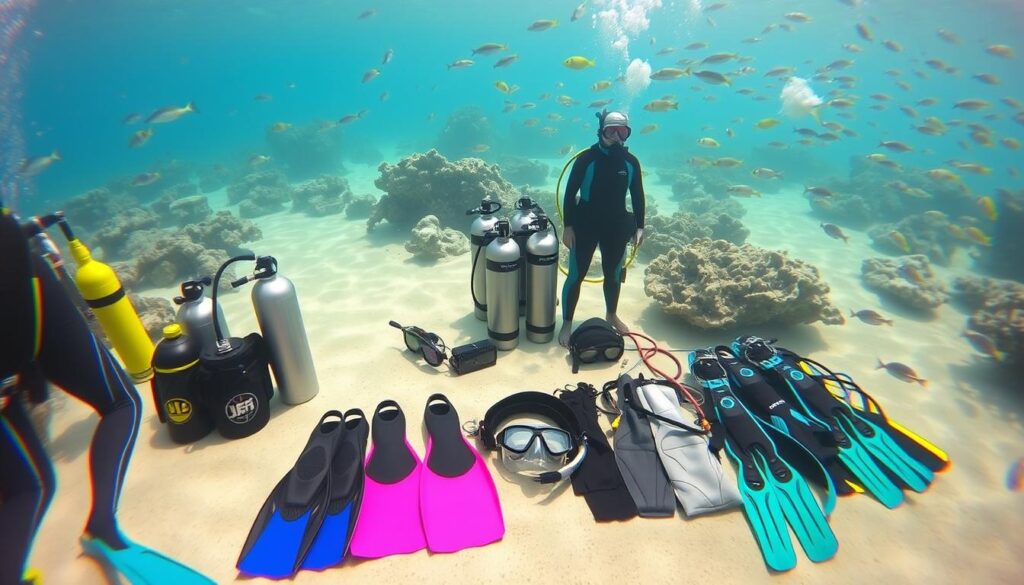
Pros and Cons of Renting Gear
Renting diving gear has many benefits for those exploring the Red Sea:
- It’s cheaper for those diving occasionally
- It saves you from carrying heavy gear
- You get to use the latest equipment
- You don’t have to worry about maintenance
Tips for Buying Your Own Equipment
Buying your own gear is a good idea if you dive often. Look into getting:
- Mask
- Snorkel
- Wetsuit
- Fins
“Personal gear ensures comfort, fit, and familiarity underwater.” – Professional Diving Instructor
Where to Rent Gear in Egypt
For renting gear in Egypt, choose well-known dive centers. They offer top-notch equipment and service.
| Rental Item | Average Daily Cost | Recommended Check |
|---|---|---|
| Complete Gear Set | $30-$70 | Equipment condition |
| Wetsuit | $10-$20 | Proper size |
| Scuba Tank | $15-$25 | Pressure test |
Pro tip: Arrive early during peak diving seasons to secure the best-fitting rental equipment for your Red Sea adventure.
Safety Tips for Diving
Scuba diving in Egypt’s Red Sea needs careful safety steps. Divers know that being ready makes the dive amazing. They say knowing the risks is key to enjoying the Red Sea’s beauty.
Understanding Depth Limits
Managing depth is vital for safe diving in the Red Sea. Here are some depth rules:
- Open Water Divers: Maximum depth of 30 meters
- Advanced Open Water Divers: Up to 40 meters
- Technical divers: Can explore deeper underwater environments
Dive Buddy System Essentials
The dive buddy system is a must for safety in Egypt. Having a trained partner means you both watch each other’s back and can act fast in emergencies.
Emergency Procedures
Being ready for emergencies is lifesaving. Here are key steps for Red Sea diving:
- Carrying emergency oxygen equipment
- Maintaining complete dive insurance
- Knowing how to handle decompression
| Safety Requirement | Recommendation |
|---|---|
| Dive Computer | Mandatory individual use |
| Safety Buoy | Required when diving without guide |
| Medical Preparedness | Recommended travel insurance |
“Safety doesn’t happen by accident. It’s a deliberate choice in every dive.” – Professional Diving Instructor
Remember: Knowing these safety tips makes your dive unforgettable.
Underwater Photography Tips
Capturing the underwater world of Egypt’s Red Sea needs skill and the right gear. Exploring this marine paradise lets photographers show off stunning marine life in clear waters.
Recommended Gear for Photographers
Choosing the right equipment is key for great underwater shots. Both pros and hobbyists should look at these items:
- Waterproof camera housing
- Wide-angle lens for marine landscapes
- Macro lens for detailed marine life shots
- Underwater strobe lights
- Color correction filters
Best Practices for Capturing Marine Life
When taking photos of marine life, focus on quality and respect the environment. Move slowly and don’t scare the animals.
| Technique | Purpose |
|---|---|
| Maintain Distance | Prevent scaring marine animals |
| Use Natural Light | Capture authentic marine environment |
| Fast Shutter Speed | Freeze marine movement |
Editing Your Underwater Photos
Editing can make good underwater photos amazing. Editing brings back lost colors and makes marine life details pop.
“The magic of underwater photography lies not just in capturing the moment, but in revealing the hidden beauty of marine ecosystems.” – Professional Marine Photographer
With practice and patience, photographers can tell amazing stories of Egypt’s marine life. They help preserve the Red Sea’s incredible biodiversity for the future.
Marine Conservation Efforts
The Red Sea’s marine ecosystem is home to a wide variety of marine life in Egypt. Protecting these underwater worlds is a big job. It needs the help of divers, researchers, and local groups.
Importance of Coral Reefs
Coral reefs in the Red Sea are facing big challenges. If the Earth’s temperature goes up by 1.5°C, we could lose 70% to 90% of coral reefs. The Red Sea has over 150 square miles of coral reefs. It’s one of the longest living reef systems in the world.
Organizations Supporting Marine Conservation
- HEPCA (Hurghada Environmental Protection and Conservation Association)
- Green Fins
- PADI Eco Centers
- Turtle Watch
Some amazing conservation efforts include:
- HEPCA’s mooring buoy network with over 1,000 installations
- Reducing reef damage by 70% through strategic interventions
- Implementing sustainable diving practices
How Divers Can Help
Red Sea Diving fans can make a difference in marine conservation. Here are some ways to help:
- Participate in weekly clean-up dives
- Join PADI’s Dive Against Debris program
- Support eco-friendly dive operators
- Report marine debris and endangered species
“Every dive is an opportunity to protect and preserve our marine environments.”
Divers play a key role in protecting marine ecosystems. By taking action, they help keep the incredible Marine Life in Egypt safe for the future.
Special Diving Experiences
The Red Sea is a treasure trove for divers. It offers unique underwater adventures that go beyond the usual. Diving Destinations Egypt provides special chances for those who love the sea.
Exploring the Red Sea in Egypt is an exciting journey. It’s perfect for those who want to see the wonders of the sea.
Night Diving Adventures
Night diving turns the sea into a magical world. Divers see creatures that hide during the day. They see:
- Nocturnal hunting behaviors
- Bioluminescent organisms
- Unique marine interactions
Cave Diving Excursions
For the brave, Egypt’s underwater caves are a must-see. Dahab’s Blue Hole is a deep dive for experts. It’s over 300 feet deep.
Shark Diving Opportunities
The Red Sea is great for shark sightings. The best times are:
| Shark Species | Peak Season | Typical Location |
|---|---|---|
| Oceanic Whitetips | October-November | Brothers Islands |
| Hammerhead Sharks | May-June | Elphinstone Reef |
“The Red Sea offers some of the most spectacular shark diving experiences in the world.” – Marine Expedition Magazine
Make sure you have the right skills and follow experts for these dives.
Cultural Considerations for Divers
Scuba diving in Egypt is more than just exploring underwater landscapes. It’s a holistic experience that requires understanding local customs, legal regulations, and marine environment respect. Diving destinations Egypt offer unique cultural interactions that can enhance your underwater adventure.
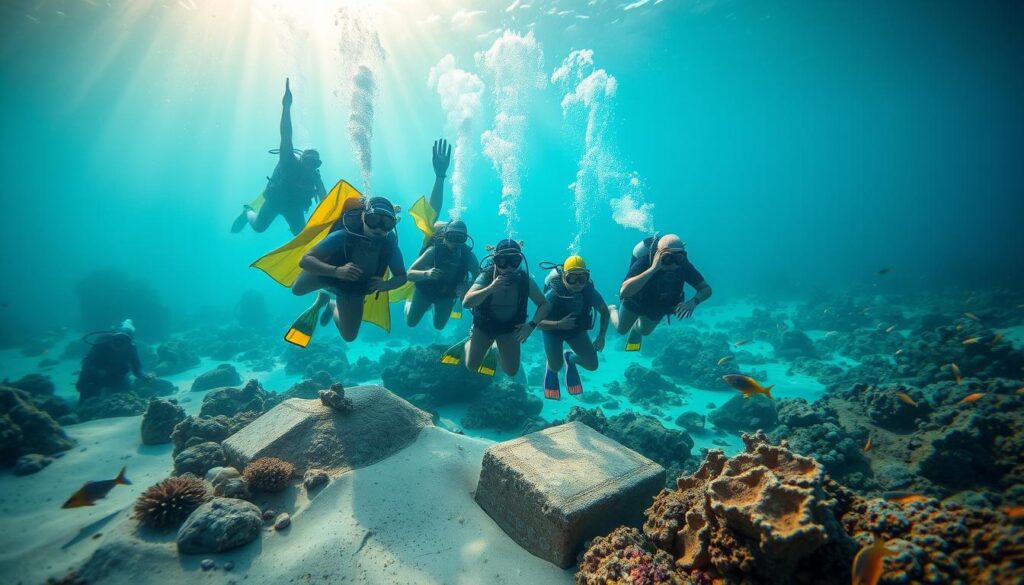
Local Customs and Etiquette
When diving in Egypt, cultural sensitivity is key. The diving community here values respectful interactions both on land and sea. Here are some etiquette tips:
- Dress modestly when not in diving gear
- Learn basic Arabic greetings
- Ask permission before photographing local people
- Tip boat crew and dive guides appropriately
Understanding Egyptian Diving Laws
Starting in 2018, Egyptian authorities have tightened control over dive centers and liveaboards. New regulations ensure diving safety and environmental protection. Here are some key legal considerations:
- Depth limits strictly set at 40 meters
- Mandatory documentation of dive profiles
- Regular equipment and safety checks
- Required dive insurance for all trips
Respecting Marine Environments
Scuba diving in Egypt means protecting its rich marine ecosystem. The Red Sea hosts 1,252 fish species, making conservation critical. Responsible divers should:
- Never touch coral or marine life
- Avoid using sunscreens harmful to marine ecosystems
- Follow designated diving routes
- Participate in local marine conservation efforts
“Responsible diving is not just about exploring, but preserving the underwater world for future generations.”
Dive Certifications Explained
Scuba diving certifications can seem complex for beginners. Egypt’s Red Sea is perfect for learning and improving your diving skills. It offers various certification levels.
Diving Courses Egypt offer a clear path for all divers. They cover from beginner to professional levels. These courses boost your confidence and skills in exploring the underwater world.
Certification Level Overview
- Open Water Diver: Entry-level certification
- Advanced Open Water: Intermediate skill development
- Rescue Diver: Advanced safety and emergency skills
- Divemaster: Professional-level qualification
Choosing the Right Course
When picking a Scuba Diving in Egypt certification, think about your skill level, goals, and fitness. Each course builds on what you’ve learned before. This ensures a well-structured learning journey.
| Certification Agency | Course Duration | Depth Limit |
|---|---|---|
| PADI | 2-3 days | 18 meters |
| SSI | 2-3 days | 20 meters |
| CMAS | 3-4 days | 20 meters |
Popular Certification Agencies
Egypt is home to many recognized diving certification agencies. PADI, SSI, and CMAS offer courses for all skill levels and preferences.
“Every dive is a new adventure, and every certification is a step towards mastering the underwater world.” – Professional Diving Instructor
Before picking a course, look into local dive centers and instructor credentials. Make sure the program meets international safety standards. Scuba Diving in Egypt offers a great learning environment with diverse marine landscapes and skilled instructors.
Health and Fitness for Diving
Getting ready for Scuba Diving in Egypt means focusing on your health and fitness. The Red Sea diving experience needs you to be physically ready. This ensures a safe and fun underwater adventure.
Physical Preparation for Red Sea Diving
For successful diving in Egypt’s Red Sea, staying fit is key. Experts suggest a detailed plan to get your body ready for diving.
- Cardiovascular training: 150 minutes of moderate aerobic activity weekly
- Strength training: Muscle-strengthening activities twice a week
- Flexibility exercises: Focusing on core and upper body strength
Essential Health Considerations
Divers need to know about health issues specific to Scuba Diving in Egypt. Getting a medical check before diving is very important.
| Health Aspect | Recommended Check |
|---|---|
| Cardiovascular Health | Full medical examination recommended |
| Lung Function | Pulmonary function test advised |
| Age Considerations | Special attention for divers over 45 |
Staying Hydrated and Healthy
Staying hydrated is key during Red Sea diving. Experts say to drink water before, during, and after diving.
“Your body is your most important diving equipment. Treat it with care and respect.” – Professional Diving Instructor
- Drink at least 2-3 liters of water daily
- Avoid alcohol before diving
- Eat nutritious, light meals
- Get adequate rest before diving days
By following these health and fitness tips, divers can stay safe and enjoy Egypt’s Red Sea underwater world.
What to Expect on a Diving Trip
Diving in Egypt’s Red Sea is an amazing underwater adventure. It needs careful planning and getting ready. A daily routine helps you explore the sea fully and makes your trip unforgettable.
A typical day of diving in Egypt is well-planned. It aims to give divers the best experience and keep them safe. Knowing the daily plan helps you get ready for your dives.
Daily Diving Itinerary
Your diving day starts early. Most places follow a set schedule:
- Early morning wake-up (5:30-6:00 AM)
- Light breakfast
- First dive briefing
- Morning dive session
- Surface interval and rest
- Lunch break
- Afternoon dive
- Evening equipment maintenance
Equipment Setup and Dive Briefings
Red Sea diving operators check your gear and explain the dive. They make sure your equipment is good and talk about safety before you dive.
| Equipment Check Areas | Duration |
|---|---|
| Regulator inspection | 15 minutes |
| BCD functionality | 10 minutes |
| Wetsuit and mask fitting | 10 minutes |
Post-Dive Activities and Relaxation
After diving, you can relax. Most dive boats have comfy spots for resting, checking dive logs, and talking with other divers.
“The Red Sea provides not just a dive, but a complete maritime experience” – Professional Diving Instructor
Water temperatures are between 21°C and 30°C all year. This makes Egypt a top spot for diving.
Accommodations for Divers
Finding the right place to stay after diving in Egypt is key. The Red Sea has many places to stay, from fancy resorts to more affordable choices.
Best Hotels Near Dive Sites
The Red Sea has top hotels near amazing dive spots. The Four Seasons Resort is a standout. It has its own diving center and is close to famous sites like Ras Mohamed and the SS Thistlegorm wreck.
- Renaissance Sharm El Sheikh Golden View Beach Resort: Features a house reef accessible via a nearby jetty
- Breakers Soma Bay: Offers direct access to a vibrant house reef with diverse marine life
- Fort Arabesque Resort: House reef just 20 meters from the beach
All-Inclusive Resorts
For those who want it all, there are all-inclusive resorts. PADI Travel has packages that include diving and more.
| Resort | Diving Package Details | Unique Features |
|---|---|---|
| Desert Rose Resort | 10 boat dives per 7-night stay | 10+ on-site bars and restaurants |
| Marsa Shagra Village | Unlimited shore diving | World-renowned house reef |
| Reef Oasis Blue Bay Resort | Multilingual services | Seven swimming pools |
Budget-Friendly Options
Even on a tight budget, you can dive in style. Desert Divers Dahab Hotel & Camp has rooms for all budgets. From simple to luxury, they have it all.
“The Red Sea provides diving experiences for every traveler, regardless of budget or experience level.”
Whether you want luxury or something more affordable, Egypt has it. The right place to stay makes your diving trip even better.
Egypt Recommended Scuba Diving Itinerary
Planning a scuba diving trip to Egypt can be an exciting and rewarding experience. With an abundance of remarkable dive sites, it’s essential to create a well-rounded itinerary that allows you to explore the best that Egypt has to offer. Here’s a recommended scuba diving itinerary that covers some of the country’s most iconic dive locations:
Day 1: Arrival in Egypt, Transfer to Dive Destination
Upon arrival in Egypt, you will be greeted by the warm hospitality of this fascinating country. Depending on your chosen dive destination, you will be transferred to cities like Hurghada, Sharm El Sheikh, or Marsa Alam, which serve as gateways to Egypt’s spectacular underwater world.
Day 2-4: Dive Sites near Hurghada
Start your diving adventure by exploring the dive sites near Hurghada. Renowned for its proximity to the Giftun Islands and Abu Dabbab, Hurghada offers a variety of dive sites suitable for divers of all levels. Dive into the crystal-clear waters and marvel at vibrant coral reefs teeming with an array of marine species.
Day 5-7: Sharm El Sheikh and Ras Mohammed National Park
Travel to Sharm El Sheikh, a vibrant coastal city famous for its proximity to the stunning Ras Mohammed National Park. Spend a few days diving in the park’s renowned sites, such as Shark Reef and Yolanda Reef, where you can encounter fascinating marine creatures, including reef sharks, turtles, and schools of colorful fish.
Day 8-10: Dahab and the Blue Hole
Head to Dahab, a laid-back town on the Sinai Peninsula known for its captivating diving opportunities. Dive the famous Blue Hole, an underwater sinkhole offering unique geological formations and thriving marine life. Explore the underwater tunnel known as “The Arch” and discover the vibrant coral gardens that surround this fascinating dive site.
Day 11-14: Liveaboard Adventure in the Red Sea
Embark on an unforgettable liveaboard journey to explore remote and pristine dive sites in the Red Sea. Spend several days aboard a comfortable vessel, diving at locations such as the Brothers Islands, Daedalus Reef, and Rocky Island. Experience the thrill of diving with pelagic species, marvel at stunning coral formations, and immerse yourself in the beauty of the Red Sea’s underwater world.
Day 15-16: Back to Hurghada or Sharm El Sheikh
Conclude your scuba diving itinerary by returning to either Hurghada or Sharm El Sheikh. Take advantage of any remaining time to revisit favorite dive sites or explore new locations based on recommendations from local dive operators.
Day 17: Departure from Egypt
Bid farewell to Egypt, taking with you cherished memories of incredible scuba diving experiences. Depart from the airport with a sense of fulfillment and a longing to return to this remarkable diving destination.
It’s important to note that this itinerary is a suggested framework, and it can be customized based on your preferences, available time, and dive certifications. Egypt offers a wide range of dive sites and destinations, allowing you to tailor your itinerary to your specific interests and desired level of adventure.
Remember to consult with local dive operators or travel agents who can provide expert advice and assistance in crafting a scuba diving itinerary that best suits your needs. They can help you navigate logistics, recommend additional dive sites, and ensure a smooth and enjoyable diving experience throughout your journey.
With this recommended scuba diving itinerary, you’ll have the opportunity to explore Egypt’s diverse underwater landscapes, encounter captivating marine life, and create lasting memories of an extraordinary diving adventure.
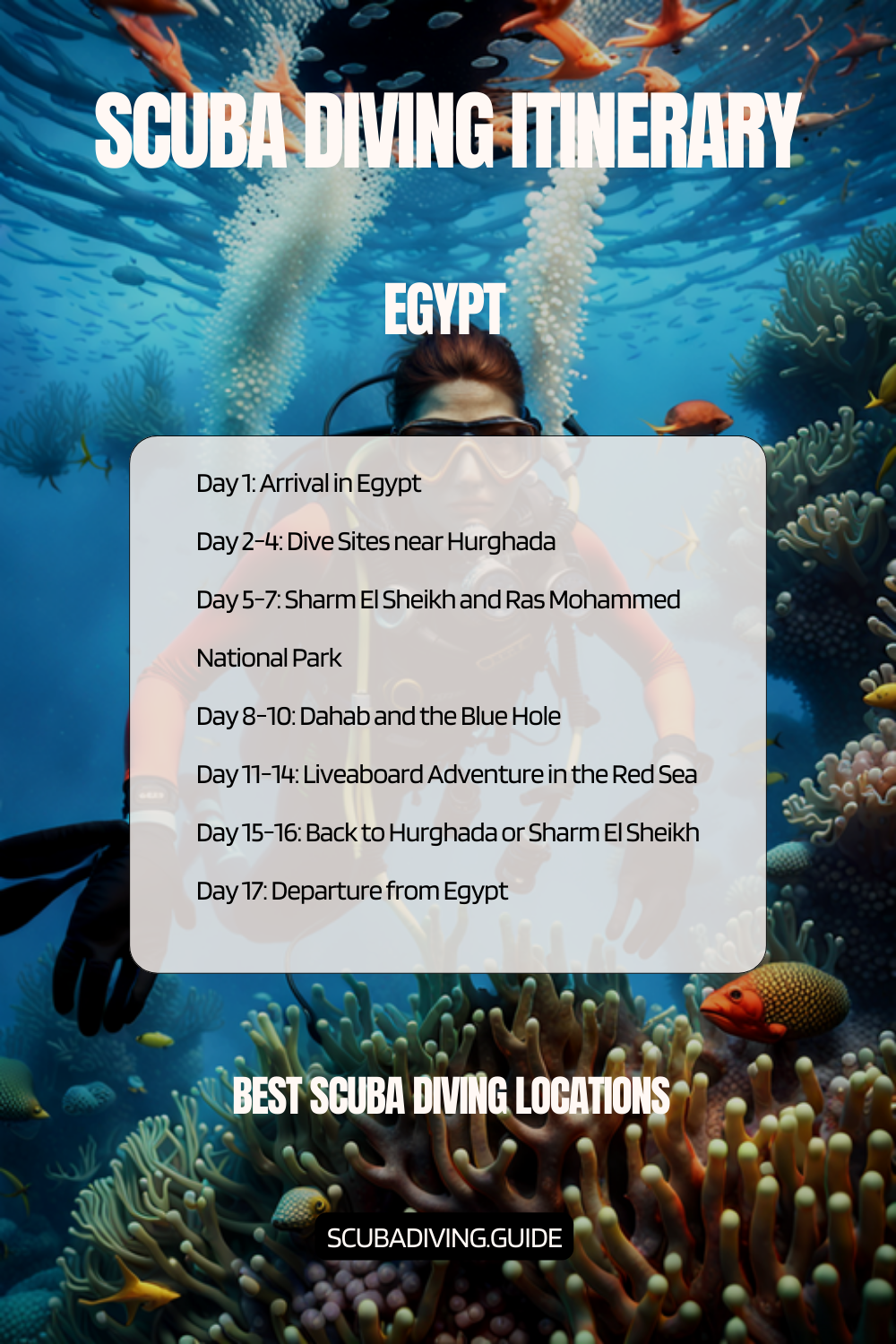
Other Countries to Consider
Conclusion: Why Choose Egypt for Your Diving Adventure
Scuba diving in Egypt is a journey into the Red Sea’s stunning marine world. It’s home to over 1,100 fish species and 200 coral types. This makes it a top spot for underwater explorers.
The Red Sea is known for its clear waters and warm temperatures. Divers can see up to 40 meters deep. The area is also home to 20% of the world’s unique marine species.
From the SS Thistlegorm wreck to Ras Mohammed National Park, each dive is unique. Professional diving centers in Hurghada and Sharm El Sheikh welcome all levels of divers. The Red Sea offers unforgettable experiences that inspire a love for the ocean.
Emerging Diving Trends
Marine conservation is key in Egypt’s diving scene. The community is working on sustainable practices. New dive sites are being found, and efforts to protect the marine environment are growing.
FAQ – Scuba Diving in Egypt
What makes the Red Sea such a special diving destination?
The Red Sea is known for its clear waters and rich marine life. It’s warm all year, with temperatures between 72-84°F. You can see up to 150 feet underwater, making it perfect for diving.
It has vibrant coral reefs and many marine species. Famous sites like Ras Mohammed National Park and the SS Thistlegorm wreck are here.
Do I need special certifications to dive in Egypt?
Most dive sites require at least an Open Water Diver certification. Beginners can get certified locally. Advanced divers should bring proof of their certification.
Some sites, like the Brothers Islands, need more experience and specific certifications.
What marine life can I expect to see while diving in Egypt?
You’ll see colorful fish, sea turtles, dolphins, and sharks. Whale sharks, hammerhead sharks, and manta rays are seasonal visitors. The Red Sea’s diverse ecosystem has something for everyone.
When is the best time to go diving in Egypt?
The best times are March to May and September to November. These months have the best temperatures and visibility. Summer is very hot, and winter might need a thicker wetsuit.
How safe is diving in the Red Sea?
The Red Sea is very safe for diving. Dive operators follow international safety standards. Most places have mild currents and clear water.
Always follow safety rules, stay within your limits, and respect local regulations.
What equipment should I bring for diving in Egypt?
Bring your own mask, snorkel, and dive computer if you can. A thin wetsuit (3-5mm) and dive log are also good to have. Make sure your gear is in good condition for warm water diving.
Are there conservation efforts I can support while diving?
Yes, many dive operators in Egypt work on marine conservation. You can join reef clean-ups, support local groups, and dive responsibly. Some centers offer eco-diving programs and educational experiences.
What are the costs associated with diving in Egypt?
Diving in Egypt is affordable. Prices vary, but single dives cost $30-$50. Multi-day trips or liveaboards are $100-$200 per day. You can find great deals in places like Hurghada and Sharm El-Sheikh.
Do I need special travel insurance for diving?
Yes, get dive-specific insurance for medical emergencies and hyperbaric treatment. Standard insurance often doesn’t cover diving. Look for policies that include recreational diving up to your level.
Can beginners enjoy diving in the Red Sea?
Absolutely! The Red Sea has many beginner-friendly sites. Dive centers offer courses and guided dives for new divers. Places like Hurghada and Sharm El-Sheikh are great for learning to dive.
